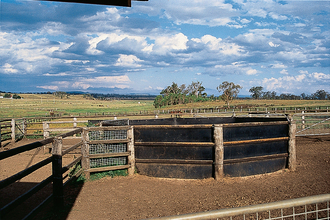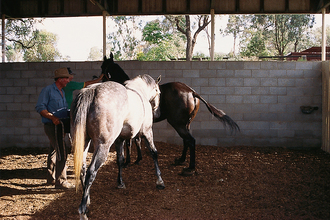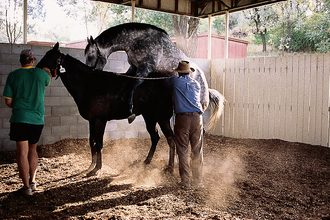Chapter 6 Pregnancy begins with delivery of the sperm to the ovum. There are several ways in which sperm can be delivered to the egg, including: Management of the teaser depends on the type and number of teasers available on the farm; for further discussion, see p. 77. • It is important to manage the mares so that they are bred the fewest number of times per cycle and have the highest conception rate possible. • Stallions must be carefully managed so that their libido is maintained and they are not over-used such that their fertility declines. The advantages of natural service are: • It is less labor-intensive than artificial insemination. • The mechanics of the process are proven. • The number of mares bred to each stallion is limited so that one stallion’s genes will not be over-used. The disadvantages of natural service are: • The danger of disease transmission. • Injury to mare, stallion or handlers may occur. • The number of mares to be bred is less than with artificial insemination. Natural service requires that the stallion physically mates with the mare. • A mare must be teased on a regular basis to establish her reproductive receptivity (heat). • Some mares that are in estrus are not receptive to the stallion. This usually affects: • The breeding shed should be large enough for movement of the mare, the stallion, and their handlers (see p. 16). • There should be good, firm, nonslippery footing (Fig. 6.1). • There should be an exit route for both the mare and the stallion should problems arise. • The mare should be hobbled or breeding boots put on her rear feet and a twitch applied (Fig. 6.2). Fig. 6.2 A mare restrained and hobbled prior to breeding. A nose twitch and hind foot boots may be required to avoid possible injury to the stallion. • The tail can be tied to one side if quick-release knots are used both on the tail and around the neck of the mare, so that the tail can be released easily if the stallion should become entangled. Otherwise, the tail can be allowed to hang. • One person should handle the mare. • A second person should handle the stallion and a third person should assist the stallion during intromission (Fig. 6.4). Fig. 6.4 Assistance with intromission will help to minimize potential injury during coitus but some stallions may not accept this. i. When the mare is found to be receptive and ready to be bred, her tail should be wrapped and the perineum washed with mild soap and warm water and rinsed thoroughly (Fig. 6.6). Fig. 6.6 Washing the perineum with warm water and careful drying of the vulvar area (including the inner margins of the vulvar lips) should precede coitus. ii. Mares that have had a previous Caslick’s operation (vulvoplasty; see p. 184) should be examined to determine if there is adequate area for penetration without the risk of tearing the vulva or injuring the stallion’s penis. i. At the start of the breeding season, the penis, fossa glandis and urethral diverticulum should all be cleaned carefully. Suitable swabs, etc. will be required for disease control. ii. The stallion’s penis should be washed with warm water prior to breeding (Fig. 6.7).2,3 Fig. 6.7 Washing the penis with warm water prior to breeding. Chemicals and strong soap should not be used. iii. After covering the mare, the penis should be washed again to rinse any contamination derived from the mare. i. Only one covering per estrous cycle is usually permitted. ii. The mare must be in estrus with a mature follicle. iii. Human chorionic gonadotropin (luteinizing hormone; 1500–3000 IU) or a deslorelin implant is administered 24 hours before mating. iv. Both mare and stallion are thoroughly cleaned with soap and warm water and dried carefully with a sterile paper towel. v. The mare’s uterus is filled with about 100– 200 ml of warmed semen extender with antibiotic added. The amount of extender used will depend on the size of the mare’s uterus. vi. Mating is fully supervised to ensure rapid and effective intromission and ejaculation. The methods commonly used for semen collection in modern stud practice are outlined on p. 62. Although there are other, cruder, methods (such as the use of vaginal sponges), these are becoming less acceptable as the technology of semen collection and use improves. It is important to realize that the correct collection of semen, precise handling of the ejaculates and the management of the mare are all vital if first conception pregnancy rates are to be kept acceptably high. • Ovulation can be timed with reasonable accuracy by administering either human chorionic gonadotropin or deslorelin. • Most mares are given the ovulatory agent when the dominant follicle is 35 mm in diameter (normally on the second or third day of estrus) and endometrial folds are present in the uterus.4 • The size of the follicle affects the mare’s ability to respond to human chorionic gonadotropin. Most mares will not respond if the dominant follicle is smaller than 35 mm. Some Warmblood mares will not respond with a 35-mm follicle, especially if it is present on the first day of estrus. In these mares, it may be best to administer human chorionic gonadotropin on the second or third day of estrus when the dominant follicle is 38–45 mm and there are prominent endometrial folds. • The majority of mares ovulate 36–48 hours after intravenous administration of 1500–3000 IU of human chorionic gonadotropin. • Deslorelin, a synthetic gonadotropin-releasing hormone agonist, designed as an implant, under the same criteria, induces ovulation in mares on average 41–48 hours after it is inserted.5 • The response to deslorelin does not appear to be so dependent on follicular size. It may be given when the dominant follicle is as small as 30 mm in diameter. • Some mares that are implanted with deslorelin have a prolonged inter-estrous interval between 28 and 45 days if they do not conceive. Removal of the implant between 42 and 48 hours after it was inserted prevents this problem from occurring. Placing the implant in the submucosa of the vulvar lips facilitates implant removal.
MATING
NATURAL SERVICE
Breeding by natural service1
The facilities
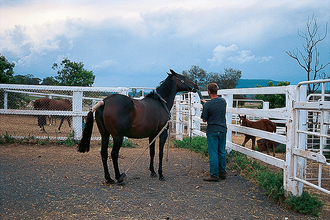
 Mares that are not receptive or are badly behaved may require sedation, but particular care should be taken to ensure that such a mare is indeed in estrus.
Mares that are not receptive or are badly behaved may require sedation, but particular care should be taken to ensure that such a mare is indeed in estrus.
 Care should be taken to not rely completely on the hobbles for protection of the stallion, since mares can still kick effectively even with hobbles on.
Care should be taken to not rely completely on the hobbles for protection of the stallion, since mares can still kick effectively even with hobbles on.
 Receptive mares will raise their tails out of the stallion’s path, and, as long as the tail is wrapped, the mare’s tail hairs will not become entangled with the stallion’s penis (Fig. 6.3).
Receptive mares will raise their tails out of the stallion’s path, and, as long as the tail is wrapped, the mare’s tail hairs will not become entangled with the stallion’s penis (Fig. 6.3).
 Minor lacerations of the glans from tail hairs can result in hemospermia and lowered overall fertility. Paddock mating more often causes injuries of this type.
Minor lacerations of the glans from tail hairs can result in hemospermia and lowered overall fertility. Paddock mating more often causes injuries of this type.
 Should lacerations occur, the breeding process may be painful for the stallion and he may become less enthusiastic.
Should lacerations occur, the breeding process may be painful for the stallion and he may become less enthusiastic.
Personnel
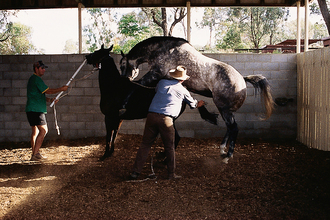
 Mares that have a ‘breeding stitch’ (not a Caslick’s suture, see below) in place at the time of mating should have this stitch moved out of the way by the same person who assists in intromission. A breeding stitch is simply a suture that is inserted to restrain the vulvar lips and limit vulvar flaccidity and the risks of damage to the Caslick site. This will prevent any injury to the stallion’s penis by the stitch. In the event that the vulva is damaged during service it is routinely repaired immediately afterwards.
Mares that have a ‘breeding stitch’ (not a Caslick’s suture, see below) in place at the time of mating should have this stitch moved out of the way by the same person who assists in intromission. A breeding stitch is simply a suture that is inserted to restrain the vulvar lips and limit vulvar flaccidity and the risks of damage to the Caslick site. This will prevent any injury to the stallion’s penis by the stitch. In the event that the vulva is damaged during service it is routinely repaired immediately afterwards.
 The same person can keep a hand on the base of the penis to palpate for urethral pulsation and confirm that ejaculation has occurred (Fig. 6.5).
The same person can keep a hand on the base of the penis to palpate for urethral pulsation and confirm that ejaculation has occurred (Fig. 6.5).
 Some stallions do not like having their penis handled in any way, making this third person’s job unnecessary.
Some stallions do not like having their penis handled in any way, making this third person’s job unnecessary.
Preparation of the mare for breeding
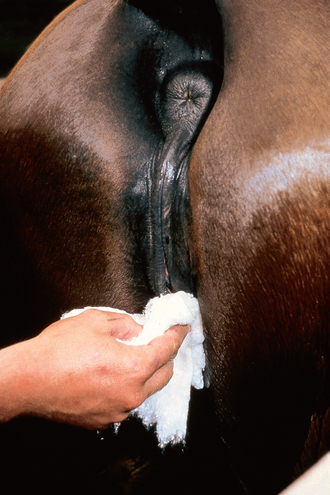
 The vulva and hairs surrounding the perineum should be dried thoroughly.
The vulva and hairs surrounding the perineum should be dried thoroughly.
 A fresh bucket and wash material are used for each mare to reduce the incidence of disease transmission.
A fresh bucket and wash material are used for each mare to reduce the incidence of disease transmission.
 If there is insufficient room for safe natural service, the suture should be opened and adequate time allowed for all bleeding to cease before the mare is bred. Damage occurring during service should be repaired immediately afterwards.
If there is insufficient room for safe natural service, the suture should be opened and adequate time allowed for all bleeding to cease before the mare is bred. Damage occurring during service should be repaired immediately afterwards.
 If there is still suture material in place, this must be removed carefully so that fecal material or other contamination is eliminated and there is less risk of injury to the stallion.
If there is still suture material in place, this must be removed carefully so that fecal material or other contamination is eliminated and there is less risk of injury to the stallion.
 Additionally, a breeding roll can be used to prevent the penis from entering too far and thereby tearing the mare.
Additionally, a breeding roll can be used to prevent the penis from entering too far and thereby tearing the mare.
Preparation of the stallion
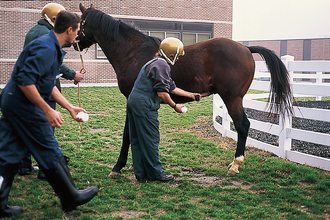
 Warm water and mild soap should be used and the penis rinsed thoroughly. This procedure tends to be stimulatory in most stallions.
Warm water and mild soap should be used and the penis rinsed thoroughly. This procedure tends to be stimulatory in most stallions.
 Once the penis is thoroughly cleaned and rinsed it should be dried.
Once the penis is thoroughly cleaned and rinsed it should be dried.
 After the initial washing of the season, only water should be used.
After the initial washing of the season, only water should be used.
 If the penis becomes excessively dirty, a mild soap can be used, again whenever considered necessary.
If the penis becomes excessively dirty, a mild soap can be used, again whenever considered necessary.
 A dismount semen sample can be obtained for evaluation by gently stripping the penis down towards the glans as the stallion dismounts. Although it is not nearly as accurate as the sperm-rich portion of the ejaculate, this allows some evaluation of the semen.
A dismount semen sample can be obtained for evaluation by gently stripping the penis down towards the glans as the stallion dismounts. Although it is not nearly as accurate as the sperm-rich portion of the ejaculate, this allows some evaluation of the semen.
 At a minimum, motility can be evaluated, and it can be confirmed that ejaculation did occur.
At a minimum, motility can be evaluated, and it can be confirmed that ejaculation did occur.
Minimal contamination breeding technique
ARTIFICIAL INSEMINATION
Use of an ovulation-inducing agent







